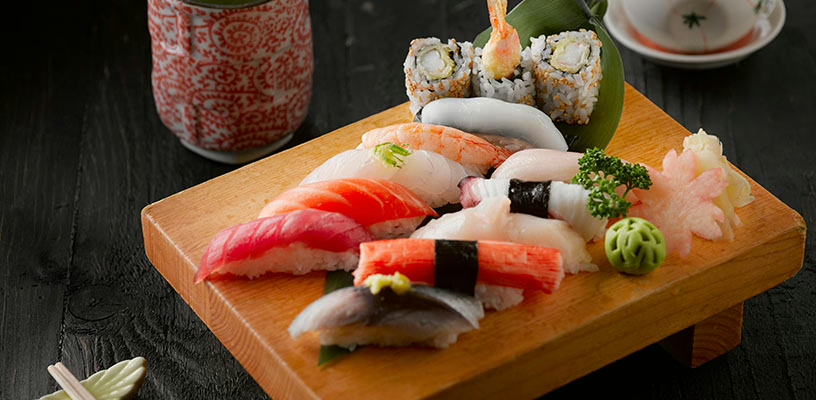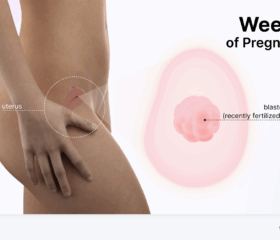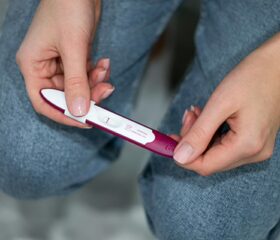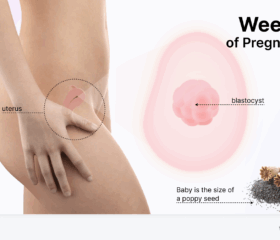10 Foods and Drinks to Avoid During Pregnancy
Pregnancy is an exciting time, but it’s not without its fair share of stresses, too. You’ll need to change many aspects of your life, including what you eat.

It’s fine to give in to your cravings while you’re pregnant (at least in moderation). However, some foods and drinks are just too risky to consume. Let’s take a look at 10 foods and drinks to avoid, learn why they’re off-limits, and what you can indulge on instead.
10 foods and drinks you should avoid during pregnancy
When you get pregnant, you might crave all sorts of tasty (and sometimes questionable) foods and treats. The good news is that the list of what to stay away from is relatively short. The bad news? Some of your favorite things might be on this list.
1. Alcohol
We’ll start with one you almost certainly already know about. You’ll need to completely avoid wine, beer, and all other alcohol when you’re pregnant. Alcohol consumption increases your risk of a whole host of upsetting and scary things, including miscarriage, premature labor, stillbirth, and sudden infant death syndrome (SIDS).
In addition, alcohol passed from mother to fetus can seriously impair your child’s development. Babies exposed to alcohol in utero can develop fetal alcohol spectrum disorders (FASDs). These disorders can affect your child’s intellectual, physical, and behavioral capabilities. 1
2. Unpasteurized dairy
Unpasteurized milk and cheese are products that are raw and haven’t been through the process that kills germs. Between 1998 and 2018, 208 outbreaks caused by people drinking unpasteurized milk led to 2,645 illnesses, as well as 228 hospitalizations. 2 3
Because of this increased risk when eating or drinking raw dairy products, it’s especially important to avoid them during pregnancy. In addition to milk, stay away from blue cheese, brie, feta, and camembert unless the labels mark them as pasteurized.
You can eat many kinds of cheese while pregnant, like cheddar, Swiss, and mozzarella. However, you should still check the labels on their packages to make sure they’re pasteurized. 4
3. Unpasteurized juices
Most of the juice on store shelves in the US is pasteurized, but you should watch out for unpasteurized juices. Unpasteurized juices haven’t been treated to kill harmful bacteria. Whether the bacteria is in the fruit or on its outer layer, it can lead to foodborne illness when you drink juices made from it.
Check the labels of any juices you want to buy at the store. Make sure they say “pasteurized.” You’ll find them in the refrigerated or frozen section. Shelf-stable juice is usually safer. However, it doesn’t need to be refrigerated, so you’ll need to more closely inspect those labels.
Also, be careful when it comes to fresh-squeezed juices, apple cider, and smoothies. Independent sellers at health food stores, juice bars, restaurants, and farmer’s markets aren’t required to label their goods as pasteurized or unpasteurized, so you’ll need to ask if you’re not sure.
Lastly, if you want to make your own juices or smoothies at home, thoroughly rinse the fruit and veggies in water first, and make sure not to leave any freshly made juices out for more than an hour. 5
4. Raw, unwashed fruits and vegetables
For the same reason, you should avoid eating any fruits or vegetables that haven’t been fully washed. Raw produce may look harmless, but it can harbor dangerous bacteria. When possible, cook and eat it shortly after it’s prepared. 5
Also, be extra careful with raw sprouts like alfalfa, broccoli, clover, and radish. The seeds of sprouts are unusually vulnerable to bacteria. If they become contaminated during the initial seeding process, it’s almost impossible to wash away the bacteria. 6 7
One last thing to be mindful of when it comes to produce is bruising. Fruits and veggies with bruises on them offer breeding ground for mold and bacteria.
5. Seafood high in mercury
If you’re a seafood lover, don’t worry! Despite what you may have heard, it’s OK to eat at least some fish when you’re expecting.
The FDA suggests that pregnant women eat at least 8–12 ounces of fish every week. Seafood is great for your heart, bone health, and weight management.
The nutrients found in fish are good for your developing baby, too. In particular, the omega-3, omega-6, iron, iodine, choline, iron, zinc, vitamin B12, vitamin D, and selenium found in fish are great for your baby’s brain, spinal cord, and immune system development. 8
The problem is that some fish (particularly larger ones that are higher on the food chain) tend to have high levels of mercury in their bodies. The key to safely eating seafood during pregnancy is to choose fish that don’t have this problem. 9
Best and worst seafood choices according to the FDA
According to the Food and Drug Administration (FDA), the best seafood to eat when you’re pregnant includes a lot of very popular options (so if you’ve been wondering if pregnant women can eat shrimp, the answer is yes).
Here are the FDA’s top picks for pregnant women:
- Anchovies
- Atlantic mackerel
- Catfish
- Clams
- Crawfish
- Flounder
- Freshwater trout
- Lobster
- Oysters
- Pollock
- Salmon
- Sardines
- Squid
- Tilapia
Some kinds of seafood get more complicated. For example, while pregnant women can eat tuna, it depends on the variety. Canned light tuna is listed among the FDA’s best choices, but yellowfin tuna is only listed among the “good choices,” meaning it’s okay but not the best.
Bigeye tuna is a big no-no, along with other fish that are higher up on the food chain, like king mackerel, shark, and swordfish.
6. Undercooked seafood, meat, and poultry
Raw or undercooked meat, poultry, and seafood present a much greater risk of bacterial or parasitic infections than cooked food. Sorry, sashimi lovers, you can’t eat sushi with raw fish while pregnant.
How to make sure seafood, meat, and poultry are safe to eat
When you cook at home, there are certain things you can do to ensure your meat, poultry, and seafood are safe.
Start by refrigerating or freezing everything as soon as you bring it home. Your fridge should be around 40°F and your freezer should be around 0°F.
Also, separate your meat from everything else. This way, you’ll prevent juices from leaking out and introducing bacteria into other food.
Lastly, invest in a food thermometer if you don’t already have one. Here are the FDA’s cooking recommendations:
- Cook seafood until it reaches 145°F.
- Cook ground meat until it reaches 160°F.
- Cook cuts of meat until they reach 145°F, with 3 minutes of rest.
- Cook ground poultry and cuts until they reach 165°F.
If you’re not sure when your seafood is done, take a look at it. Fish should be opaque and flaky. Shellfish like lobster, scallops, and shrimp should be opaque and firm. Shellfish still in their shells, like clams, mussels, and oysters, are cooked when their shells open. 9 (If their shells don’t open, don’t eat them!)
Fully clean any surfaces, dishes, cutting boards, and other cooking implements that touch raw foods. Wash your hands with warm soap and water to prevent the spread of bacteria as well.
7. Refrigerated smoked seafood
Refrigerated smoked seafood, such as smoked salmon, can contain a form of bacteria known as listeria. While the seafood itself might appear on the “best” or “good” list of seafood to eat above, the preparation can be harmful.
Look for labels like:
- Kippered
- Jerky
- Lox
- Nova-style
- Smoked
When you’re pregnant, you shouldn’t eat anything with those labels on its own, without preparing it further. However, you can make it safe by cooking it; smoked fish in a casserole, for instance, should be safe. Also, smoked seafood in canned or otherwise shelf-stable packaging is OK to eat, too. 10
8. Undercooked eggs
Eggs that are raw or undercooked can put you at risk of salmonella. Only eat eggs that are fully cooked (including eggs in other dishes).
Here are some tips for safely enjoying eggs during your pregnancy:
- Use pasteurized eggs whenever possible.
- Cook scrambled eggs until they’re firm.
- Cook fried eggs for at least 2 or 3 minutes per side.
- Cook all dishes containing eggs to 160°F.
- Avoid sauces that contain raw eggs, like hollandaise and some mayo.
Also, if you like baking, don’t lick the batter or eat the raw dough (no matter how good it tastes). It poses just as great of a risk as eating prepared dishes with undercooked eggs. 11 10
9. Deli counter foods
Although listeria infections are rare, the CDC strongly advises against women eating deli foods (which, like smoked fish, can contain this bacteria). The list of foods to avoid when you’re pregnant includes: 12
- Cold cuts like ham, turkey, and bologna
- Cured meats like pepperoni, prosciutto, and salami
- Hot dogs
- Refrigerated meat spreads or pates
- Deli salads like coleslaw and egg salad
Although it’s a good idea not to buy these foods at the store, some of them you can prepare safely at home. For instance, pregnant women can eat hot dogs, pepperoni, and similar meat if they’re cooked to 165°F. Also, it’s fine to make homemade salads with fully cooked and pasteurized ingredients.
10. Food that’s been out for a while
You’re going to be pregnant for about 9 months, which means there are going to be tons of occasions filled with tasty snacks laid out for you to eat.
Unfortunately, if you’re not sitting down to a freshly prepared meal, these kinds of scenarios can be problematic when it comes to food safety. That means buffets, cookouts, picnics, potlucks, and other such food-centric gatherings. The longer food has been sitting out, the longer bacteria has had to grow in it.
You don’t have to skip these events when you’re pregnant. You’ll just need to make different choices than you might’ve when you weren’t. For instance, go for food that’s: 4
- Canned or shelf-stable
- Stored in the refrigerator or freezer
- Chilled or kept on ice
- Meant to be warm and has been heated to 140°F
Also, be mindful of the temperature. Bacteria tend to grow on food more readily the warmer it gets. In general, skip food that’s been out for more than 2 hours at room temperature. If you’re outside on a really hot day (90°F or higher), then that food is really only going to be good for about an hour. 7
Let your doctor know if you crave non-food items
If you crave things like dirt, clay, or paint (a condition called pica), let your doctor know right away. You may experience pica during your pregnancy if you’re lacking minerals and nutrients such as zinc or iron.
Food and drinks you can have in moderation while pregnant
While some things are completely off-limits, others are safe to eat and drink in moderation. Here’s a list of food you can consume, but that you should indulge in sparingly:
- Caffeinated beverages: If you’re worried that the ideal pregnancy breakfast forgoes a hot cup of Joe, here’s some good news for you. You can still have caffeine when you’re pregnant, whether it comes in coffee, tea, energy drinks, or chocolate. However, the recommendation is to have no more than 200 mg per day, which corresponds to about 12 ounces of coffee. 13
- Herbal teas: While many herbs are safe, there are some that can have adverse effects on your pregnancy when consumed in excess, like peppermint, fennel, and ginger. To be safe, stick to herbal teas with small amounts of herbs and ones that are known to not be toxic. 14 15
- Junk food: While occasional treats are fine, limiting junk food that’s high in sugar, fat, and calories with low nutritional value keeps you and your baby healthy. It’ll also make it easier to stick to a healthy weight throughout your pregnancy. 13 16
- Seaweed: Pregnant women can eat seaweed, but you’ll need to ask your doctor how many servings are okay for you each week. Brown varieties like hijiki are also potentially harmful to you during your pregnancy, so try to avoid them.
Why certain foods are off-limits during pregnancy
There are several reasons why you can’t eat certain foods when you’re pregnant. As you’ve probably picked up, foodborne illness is a major one. Even mild cases may lead to an upset stomach and diarrhea, and severe cases can pose a serious risk to your health.
(Note that diarrhea can be a sign of pregnancy, which means that even with a perfect pregnancy-appropriate diet, it might not be completely avoidable—but you still want to avoid eating anything that’ll make it any worse.)
Why pregnant women are so vulnerable to foodborne illnesses
When you’re pregnant, your immune system changes. This is why mothers-to-be are more susceptible to foodborne microorganisms. Your fetus’s underdeveloped immune system is also vulnerable during this time.
However, it’s not just foodborne illness that could affect your baby. Certain toxins and substances (like alcohol) can affect fetal development and cause long-term health issues. 17
With all that said, don’t stress over this too much—if you accidentally have one bite of a bologna sandwich, your chances of getting sick are low. What’s important is that you stay mindful of this on a day-to-day basis and make safe and healthy food choices as best as possible.
What are the most common (and most dangerous) foodborne illnesses?
Let’s look at some of the most common foodborne illnesses to watch out for when you’re expecting:
Listeria
Listeria monocytogenes are bacteria that come from unsanitary food production and storage conditions. Listeria is most commonly found in refrigerated and ready-made food like meat, poultry, seafood, dairy, and produce. Unpasteurized foods also have a high risk of carrying it. 18
Although the immediate symptoms of listeria during pregnancy can be mild, it’s very important to see your doctor and get treated if you know you’ve been exposed to listeria. Untreated infections can lead to:
- Premature delivery
- Low-birth weight
- Health problems for your infant
- Various types of miscarriages
- Stillbirth
Pregnant women are 10 times more susceptible to developing an illness from listeria than other adults. 19
Toxoplasma gondii
Toxoplasma gondii is a parasite that develops in a number of places. It can be found in raw meat, unwashed produce, contaminated water or soil, and even cat litter boxes.
Toxoplasmosis isn’t always easy to spot, but you may experience symptoms like swollen glands, muscle pain, and a stiff neck. An infection can also saddle your child with long-term consequences like blindness, hearing loss, and intellectual disability.
Getting toxoplasmosis during pregnancy is not common, but presents serious risks all the same. Each year, anywhere between 300 and 4,000 fetuses are infected with toxoplasmosis in the United States. If untreated, 80% of these children will develop serious impairments before they turn 20. 20
Salmonella
Salmonella is a bacteria that causes gastrointestinal illness. It’s often spread by people preparing food in an unsanitary manner. Eating raw or undercooked meats and seafood increases your chances of getting salmonellosis.
People usually become ill within 3 days of encountering salmonella. In most people, the symptoms (like diarrhea, cramps, and fever) will fade after 4–7 days, but salmonella can be especially dangerous when you’re pregnant and your immune system is weak.
Pregnant women who’ve been infected may have an elevated risk for miscarriage. It can also increase the chances of a preterm delivery or a low birth weight. 21 22
Escherichia coli
Escherichia coli (E. coli, for short) is more or less a harmless bacteria that lives inside the intestines of animals and humans.
Most commonly, an E. coli contamination happens when people ingest food or water that’s come into contact with feces. Usually this happens because of unsanitary food handling. Eating raw or undercooked meat or poultry, raw milk or cheese, and unwashed leafy greens or sprouts can also increase the risk.
The most common symptoms of E. coli infection are cramping, diarrhea, fever, and vomiting. Severe infections are possible, leading to bloody stools and kidney failure. However, in most cases, the infection clears up on its own within 5 to 7 days.
One of the biggest risks to pregnant women is the dehydration that often comes with an E. coli infection. Also, it can create problems during your pregnancy, like preterm delivery and stillbirth. Babies born with E. coli may also be underweight or sick. 23 24
How to avoid contracting foodborne diseases while you’re pregnant
In addition to the safe food handling and preparation tips mentioned above, there are other things you can do to avoid foodborne disease:
- If you’re going to eat ready-made foods, eat them as soon as possible. The longer they spend in the fridge or out on the counter, the greater the likelihood that bacteria will grow on them.
- Keep your refrigerator clean. If you spill something, clean it up, and use hot water and mild detergent to rinse everything from the walls to the shelves.
- Throw out foods that have expired or have begun to spoil. This includes fruit and vegetables that have developed bruises.
- Sanitize your countertops and cutting boards after making food with potential contaminants. Combine one tablespoon of bleach for every gallon of water.
- Fully wash and sanitize utensils, plates, or containers that came into contact with unwashed produce, raw foods, or other potential contaminants.
Pregnant women with pets need to be particularly careful
Pet food and water bowls can also be a source of contamination. Keep their dishes just as clean and sanitized as your own. Also, be sure to wash your hands after handling them to prevent cross-contamination.
How to maintain a balanced diet while you’re pregnant
Now that you know all about the things you shouldn’t do when you’re pregnant, let’s wrap up by talking about what you should do.
Most women will gain between 25 and 35 pounds during pregnancy. If you were underweight or overweight when you got pregnant, you may need to gain more or less. 25
Regardless, in order to gain the right amount of weight and nourish your baby, you’ll have to take in more calories every day than you’re used to, and while you have to avoid certain foods, this means you can indulge in a lot of healthy pregnancy snacks, too. For example, feel free to go to town on:
- Whole fruits like apples, strawberries, and bananas
- Whole grains like oatmeal, pasta, and brown rice
- Low-fat dairy like milk, yogurt, and cheese (as long as it’s pasteurized!)
- Veggies like spinach and beets
- Healthy proteins like fish, steak, and nuts
A balanced, nutritious pregnancy-friendly diet will include the key nutrients needed for your baby’s brain and spine to develop: folic acid, iron, iodine, and choline.
If you can, look for snacks that are tasty without including added sugars, saturated fat, and sodium. This will go a long way in improving your own health, as well as the health of your baby. 16 26
Final thoughts
There are many things you can’t do when you’re pregnant, and that includes consuming risky food and drinks.
While you may be dismayed about taking a break from your favorite sushi joint or having to pass up the all-you-can-eat buffets for a while, these dietary changes are necessary to make sure you and your baby stay healthy during pregnancy.
If anything, you’ll enjoy these foods even more once you bring your little bundle of joy into the world. You’ll certainly deserve a treat after all your hard work!
Article Sources
- U.S. Centers for Disease Control and Prevention. "About Alcohol Use During Pregnancy" Retrieved April 11, 2025.
- U.S. Centers for Disease Control and Prevention. "Raw Milk" Retrieved April 11, 2025.
- U.S. Food & Drug Administration. "The Dangers of Raw Milk: Unpasteurized Milk Can Pose a Serious Health Risk" Retrieved April 11, 2025.
- U.S. Food & Drug Administration. "Ready-to-Eat Foods (Food Safety for Moms-to-Be)" Retrieved April 11, 2025.
- U.S. Food & Drug Administration. "Fruits, Veggies and Juices (Food Safety for Moms-to-Be)" Retrieved April 11, 2025.
- The Pennsylvania State University. "What You Should Know About Sprouts" Retrieved April 11, 2025.
- U.S. Food & Drug Administration. "Eating Out & Bringing In (Food Safety for Moms-to-Be)" Retrieved April 11, 2025.
- U.S. Food & Drug Administration. "Advice about Eating Fish" Retrieved April 11, 2025.
- U.S. Food & Drug Administration. "Meat, Poultry & Seafood (Food Safety for Moms-to-Be)" Retrieved April 11, 2025.
- U.S. Department of Health & Human Services. "People at Risk: Pregnant Women" Retrieved April 11, 2025.
- U.S. Food & Drug Administration. "Dairy and Eggs (Food Safety for Moms-to-Be)" Retrieved April 11, 2025.
- U.S. Centers for Disease Control and Prevention. "Preventing Listeria Infection" Retrieved April 11, 2025.
- U.S. Department of Health and Human Services. "Health Tips for Pregnant Women" Retrieved April 11, 2025.
- Medeniyet Medical Journal. "Frequently Used Herbal Teas During Pregnancy - Short Update" Retrieved April 11, 2025.
- American Pregnancy Association. "Herbal Tea & Pregnancy" Retrieved April 11, 2025.
- Office of Disease Prevention and Health Promotion. "Eat Healthy During Pregnancy: Quick Tips" Retrieved April 11, 2025.
- U.S. Food & Drug Administration. "What Is Foodborne Illness? (Food Safety for Moms-to-Be)" Retrieved April 11, 2025.
- KidsHealth. "Listeria Infections" Retrieved April 11, 2025.
- U.S. Food & Drug Administration. "Listeria (Food Safety for Moms-to-Be)" Retrieved April 11, 2025.
- U.S. Food & Drug Administration. "Toxoplasma (Food Safety for Moms-to-Be)" Retrieved April 11, 2025.
- U.S. Food & Drug Administration. "Salmonella (Salmonellosis)" Retrieved April 11, 2025.
- Mother To Baby. "Salmonella" Retrieved April 11, 2025.
- U.S. Food & Drug Administration. "Escherichia coli (E. coli)" Retrieved April 11, 2025.
- Mother To Baby. "Escherichia coli (E. coli)" Retrieved April 11, 2025.
- MedlinePlus. "Pregnancy and Nutrition" Retrieved April 11, 2025.
- Dietary Guidelines for Americans. "Build a Healthy Eating Routine When You're Pregnant or Breastfeeding" Retrieved April 11, 2025.







